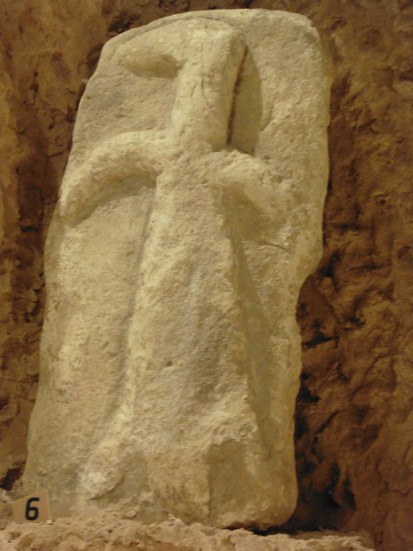
Stone
carving found at Göbekli Tepe. Does it show a penguin or a great auk? (Pic
credit: Andrew Collins)
PENGUIN
OR GREAT AUK?

Stone
carving found at Göbekli Tepe. Does it show a penguin or a great auk? (Pic
credit: Andrew Collins)
PENGUIN
OR GREAT AUK?
A NEWLY UNVEILED CARVING OF A SEABIRD FOUND AT GÖBEKLI TEPE OPENS THE DEBATE OVER THE GEOGRAPHICAL ORIGINS OF ITS POWER ELITE
A
REPORT BY ANDREW COLLINS
With
the opening of Sanliurfa's new archaeological museum full attention has been given
to its incredible reconstruction of Göbekli Tepe's Enclosure D, complete
with its twin monoliths standing an almighty 5.5 metres (18 feet) high, and its
stone-by-stone reconstruction of Nevali Çori's cult building. This was
saved from destruction in 1992 when the site was drowned by the rising waters
of the Euphrates river following the opening two years earlier of the Ataturk
dam.
Other large exhibit rooms contain literally hundreds of portable objects and carved stone fragments retrieved from these two Pre-Pottery Neolithic sites, which thrived between 11,500 and 10,000 years ago. Many of these artefacts have never been seen before in public. Some have not even appeared in books and articles, giving the curious their first look at prehistoric art that might well throw considerable light on the origins of those who created these incredible monuments so soon after the end of the last Ice Age.
Stone
Age Menagerie
Of particular interest is an entire display area, open for inspection without the hindrance of protective glass. It contains a virtual menagerie of stone age creatures found during excavations at Göbekli Tepe. Emerging from their limestone matrixes are bug-eyed lizards, fearsome boars, terrifying predators, as well as other more nightmarish creatures almost beyond recognition. Some are high reliefs on stone panels, while others are freestanding, 3D statues, very often detached fragments from much larger architectural features, such as T-shaped pillars and porthole stones. They are amazing works of art unlike anything else seen in the ancient world during this distant epoch. Some of my colleagues, particularly Hugh Newman and Graham Hancock (see Hancock, 2015), rightly point out the similarities between the artistic style and general appearance of these strange creatures and other similar examples of 3D rock art seen in such far flung places as Sulawesi in Indonesia, Rapanui/Easter Island in Polynesia, Costa Rica in Central America and Peru in South America. Such commonalities raise the question of cross-cultural contact between the earliest peoples of these distant lands and the builders of Göbekli Tepe.
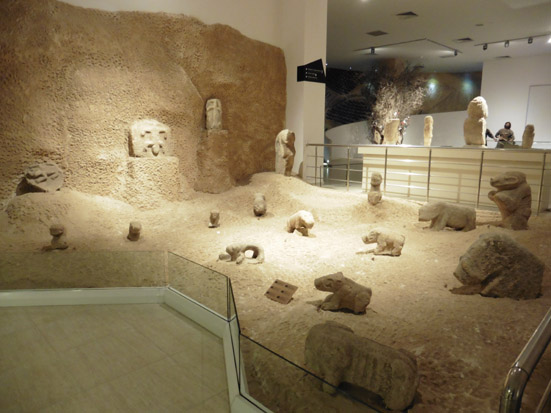
1.
Stone carvings of animals and creatures found at Göbekli Tepe and now on
display at Sanliurfa's new museum of archaeology. The seabird carving is against
the rear wall(pic credit: Andrew Collins).
It's a Penguin!
As I was photographing the various exhibits in this display area, one carved panel caught my attention. It is mounted on the rear wall and shows a bird in an upright position, with long tapered body, an L-shaped head and extended beak; tiny outstretched wings and a small wedge-shaped tail. The carving was of a flightless bird. This seemed certain. Yet from its webbed feet and general appearance there seemed little doubt it belonged to the penguin family. No other bird matched all the various components. It had to be a penguin, raising the question of why no mention of this beautiful carving was made by Joris Peters and Klaus Schmidt in their authoritative review of Göbekli Tepe zoomorphic art and faunal remains, published in 2004 (Peters and Schmidt, 2004).
Yet if it was a penguin, how did the Göbekli builders come to witness a flightless seabird only indigenous to the southern hemisphere? Indeed, biogeographical maps show that penguins are found only in Antarctica, off the cape of South Africa, on the southern coasts of Australia, on the west coast of South America and on the Galapagos Islands of the Pacific. No species of penguin are known in the northern hemisphere.
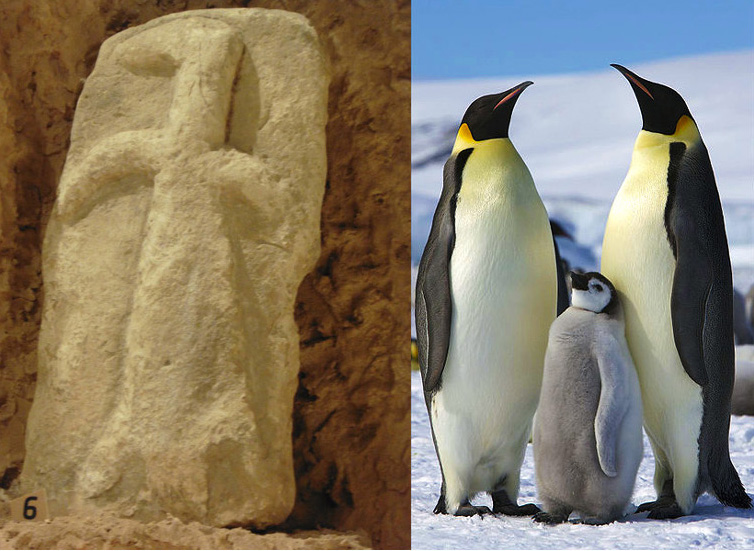
2
& 3. Left, the penguin-like seabird seen on a stone panel found at Göbekli
Tepe and now on display in Sanliurfa's new museum of archaeology (pic credit:
Andrew Collins) and, right, penguins on Antarctica (pic credit: Wiki commons licensing
agreement).
And the Dodo!
If the bird carved on the stone plaque found at Göbekli Tepe is indeed a penguin then it strongly suggests the Göbekli builders, or their forerunners, witnessed penguins somewhere in the southern hemisphere and brought with them a memory of this bird to southeast Anatolia. Adding weight to this argument is the presence on some of the stones at Göbekli Tepe, especially on the pedestal supporting one of the twin central pillars of Enclosure D, of another species of flightless bird - one that resembles the dodo. Until hunted into extinction by Europeans in the seventeenth century, the dodo was native only to Mauritius, an island east of Madagascar in the Indian Ocean. Once again, this is an area of the globe well south of the equator.
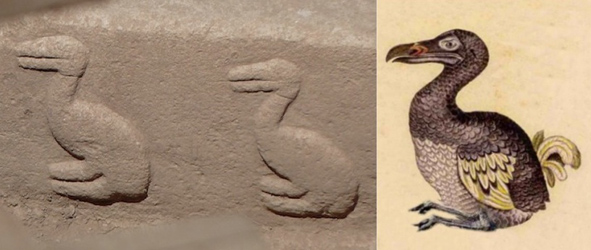
4
& 5. Dodo-like birds on the pedestal holding up one of the two twin monoliths
in the middle of Göbekli Tepe's Enclosure D and, right, illustration of a
seated dodo.
Sundaland
Destruction
Such evidence could provide support for the slowly building theory that the Göbekli builders were survivors of a long civilization that once thrived on the former landmass of Sundaland. This was partially submerged through rising sea levels following the cessation of the Younger Dryas cold spell, ca. 9600 BC, its remaining high ground forming what is today the Malay Archipelago, which includes the islands of Indonesia and Borneo. This mini ice age had, most likely, been triggered some 1,300 years earlier by what we know today as the Younger Dryas Boundary impact event, caused when multiple fragments of a disintegrating comet bombarding the planet sometime around 10,900-10,800 BC.
It
is a theory that might well help explain the similarities in stone carving found
at Göbekli Tepe and also in Indonesia, Polynesia, Central and South America,
as they could all have been the product of surviving communities from Sundaland's
lost civilization. This seems to have possessed sea-faring capabilities and left
behind as a legacy the megalithic complex at Gudung Padang in Indonesia's West
Java province. The deeper levels of this important pyramid-like site have recently
be dated as "pre-8000 BC" by a geological team working under the leadership
of Javanese geologist Danny Hilman Natawidjaja of LabEarth at the Indonesian Institute
of Sciences (LIPI) in Bandung.
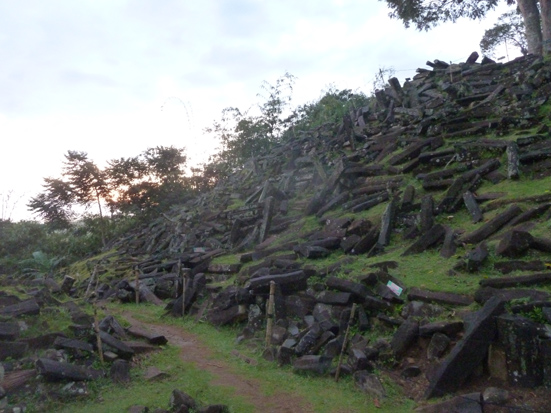
6.
Gunung Padang showing the slope that rises between its Terrace 1 and Terrace 2,
which is estimated to be at least 7,000 years (pic credit: Andrew Collins).
Although these ideas are attractive, and could easily have some basis in truth, there might well be other more prosaic answers to at least some of these most ancient of mysteries. Archaeologists will tell you that what was occurring at Göbekli Tepe some 11,500 years, when the first stone enclosures were constructed on this mountaintop site in southeast Anatolia, was the product of regional clans of hunter-gatherers coming together to create a communal religious centre to celebrate the success of the hunt.
Arrival
of the Anunnaki
Professor Klaus Schmidt, the German archaeologist under whose supervision excavations took place at Göbekli Tepe between 1995 and his unexpected death in 2014, saw the prime movers behind Göbekli Tepe's construction as a "power elite," whose memory might well have been preserved under the name Anunnaki, the gods of heaven and earth in Mesopotamian mythology (Schmidt, 2012, 206-7). They are said to have inhabited a primeval mound called Duku located on a mountain to the north of Mesopotamia called Kharsag (also written Hursag). They provided humanity with the first "sheep and grain," a metaphor for the introduction of, respectively, animal husbandry and plant domestication, both of which occurred for the first time sometime after 9000 BC in the very same region as Göbekli Tepe. Indeed, Göbekli Tepe's presence might even have helped trigger this abrupt change in lifestyle among the Pre-Pottery Neolithic population of southeast Anatolia.
If the Anunnaki were indeed Göbekli Tepe's "power elite," as Schmidt proposed, then who were these individuals and where did they come from? Did they come from Sundaland in island Southeast Asia, as many are now beginning to believe? Or did they arrive in Anatolia from somewhere else in the ancient world?
Swiderian
Dawn
In Göbekli Tepe: Genesis of the Gods I argue that Göbekli Tepe's power elite were displaced peoples known to archaeology as Swiderians, whose original homeland was Central and Eastern Europe (Collins, 2014, 168-176). The onset of the Younger Dryas cold spell caused a re-advance of the ice sheets that had been slowly receding since the end of the last major Ice Age, ca. 13,500 BC. Not only did this result in dramatic changes in flora and fauna, but it also caused a long-lasting drought across the northern hemisphere as all available water was absorbed into the re-advancing ice sheets. What this did is force European populations such as the Swiderians to migrate southwards in search of warmer and more productive climes. In their case they were funneled between the Black Sea and Caspian Sea, where they most likely settled first in and around the Caucasus Mountains and Armenian Highlands. From here it is just a short journey south into southeast Anatolia, where Pre-Pottery Neolithic sites such as Göbekli Tepe and Nevali Çori emerged in aftermath of the Younger Dryas cold spell.
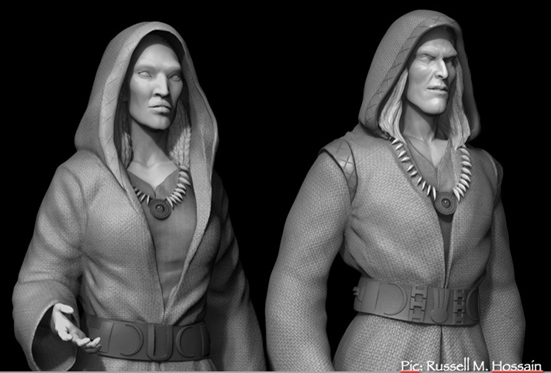
7.
Artist Russell Hossain's impression of a Swiderian male and female based on all
available anatomical evidence regarding the population's physiognomy (pic credit:
Russell Hossain).
Not only did the Swiderians carry with them unique hunting strategies, compared by Klaus Schmidt with those adopted by the Pre-Pottery Neolithic communities of southeast Anatolia (Schmidt, 2002, 10), but they also most likely introduced special stone tool making techniques, including the art of pressure flaking. This unique skill, previously popular among the Solutrean peoples of Western Europe, is found in eastern Anatolia certainly by ca. 8500-8000 BC, and arguably it had been present much earlier. Immediately prior to this time the use of pressure flaking had been common only among the Swiderian peoples in what is today the Ukraine on the northern coast of the Black Sea.
In Göbekli Tepe: Genesis of the Gods I argue also that the Swiderians introduced cosmological beliefs regarding the soul's origins in a sky-world located in the vicinity of Milky Way's northern bifurcation or fork known as the Great Rift, marked in night sky by the stars of Cygnus, the celestial bird. Similar beliefs were held by many indigenous peoples in North America prior to the historical period, suggesting that they reached the continent from Central and Eastern Asia prior to the submergence of the Beringia land bridge sometime around 8500 BC (see Little and Collins, 2014).
Eastern
Gravettians
In addition to this, I demonstrate that the Swiderians were inheritors of shamanistic practices involving key animal totems, including the wolf and fox, that originated among the Eastern Gravettian peoples, a highly advanced Upper Palaeolothic culture that thrived between 40,000 and 19,000 BC in Central Russia (Sungir and Kostenki in particular) and also in what is today the Czech Republic (at sites such as Brünn (modern Brno), Predmostí, Dolní Vestonice, and Pavlov). They possessed a fully developed goddess cult (for instance, they created the famous Venus of Willendorf goddess statue); built the first celestially aligned buildings made of mammoth bone and wood; wore tailored clothing adorned by thousands of beads, and even experimented with agriculture as much as 30,000 years ago.
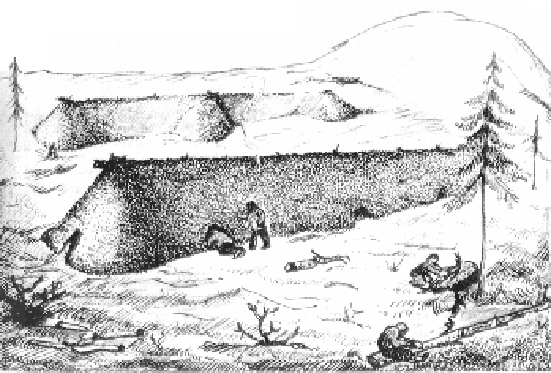
8.
Artist's impression of Eastern Gravettian long houses at Kostenki in central Russia,
ca. 30,000 years ago.
The Swiderians, as the direct successors of the Eastern Gravettians, not only reached as far south as the Caucasus region, and arguably Anatolia, but also became among the earliest post-Ice Age inhabitants of Northern Europe, their post-Swiderian descendants perhaps being the carriers of cosmological beliefs that persist even today among indigenous peoples of Finland and Scandinavia.
North
or South: What is the Answer?
Which brings us back to the carving of a flightless seabird found at Göbekli Tepe, and the birds with the likeness of dodos seen on and around some of its T-shaped pillars. Their presence could argue that the power elite behind the initial phases of construction at Göbekli Tepe came not from the north, but from the south, and more precisely the former Sundaland landmass.
So which is right? What are the true origins of the Göbekli builders? There are no hard and fast answers right now, and it could be that both solutions are correct. The Pre-Pottery Neolithic peoples of southeast Anatolia could have been ruled by a cosmopolitan group of individuals whose geographical origins were quite diverse. Indeed, in Göbekli Tepe: Genesis of the Gods I argue that it is possible that Nilotic peoples from what is today Egypt might well have had a hand in its construction. Certain comparisons that can be drawn between the layout and design of key enclosures at Göbekli Tepe and cosmological symbols preserved even today by the Dogon tribe of Mali seem to bear out this possibility, especially if their origins can be traced to the Saharan desert prior to its desiccation some 5,000 to 7,000 years ago.
Great
Auk and not a Penguin?
As for the penguin-like bird on the stone slab found at Göbekli Tepe, more likely it is a representation of a great auk (Pinguinus impennis). This was a 75 to 85 centimetre (30 to 33 inch) tall flightless seabird, a member of the alcid family, that once inhabited the rocky seashores of the Northern Atlantic. Its territories stretched from Newfoundland and New England in North America, to Greenland, Iceland, Scandinavia, Great Britain and Ireland in Northwest Europe, and from the coasts of Northern Europe across to European Russia and beyond into Eastern Asia. Moreover, the greak auk was known as far south as France and Southern Spain, while bones from the seabird were found by excavators at a Neolithic cave site in the Temara region of Morocco (Campmas, 2010). It is even reported that at certain times during the Pleistocene epoch great auks were present in Italy as well as in other parts of the Mediterranean basin.
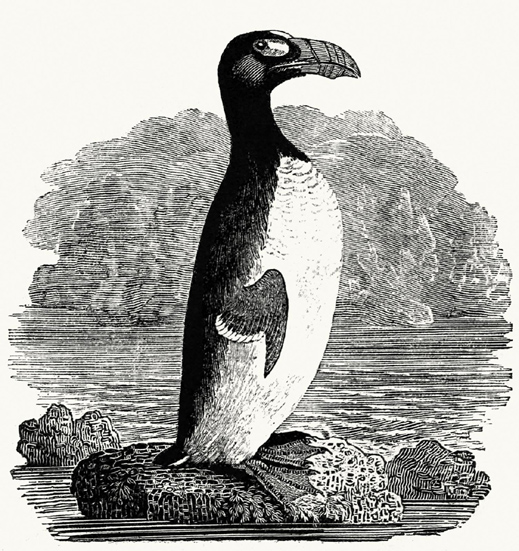
9.
Illustration of a great auk.
Like the penguin, which it greatly resembles, the great auk was clumsy on land, yet was a powerful swimmer, its main sources of food being fish and crustaceans. Somehow it managed to survive through from the Pleistocene into the Holocene, our current geological epoch, only to be hunted to extinction in fairly modern times. The last known pair of great auks were killed on Eldey Island, Iceland, in 1844, while the last known sighting of a live bird was on the Newfoundland Banks in 1852.
Pictures of the great auk show that its right-angled head and neck, its heavy black bill; long, powerful body, webbed feet, stubby tail, and tiny wings, closely match the features of the penguin-like bird carved on the stone slab found at Göbekli Tepe. The likeness is too close to ignore, making it clear that what we see here is a bird not of the southern hemisphere, but one whose home was in the northern hemisphere.
The earliest known, fully recognizable representation of a great auk is seen in the Grotte Cosquer, a cave on the Mediterranean coast of France discovered in 1991 and only accessed today via a 175 m (574 ft) long tunnel, its entrance 37 metres (121 feet) below the current sea level. Here around 19,000 years ago Solutrean cave artists created a series of drawings in black charcoal showing an assortment of Ice Age animals including bison, aurochs and horses. They also drew seals, jellyfish and auks. One image in particular of a great auk closely resembles the penguin-like bird from Göbekli Tepe.
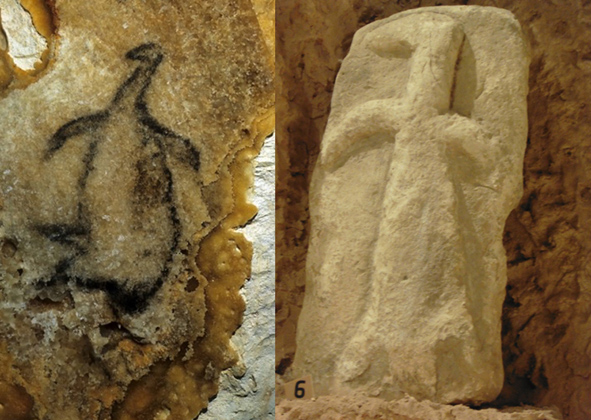
10
& 11. Left, one of the greak auk drawings from Grotte Cosquer and, right,
the penguin-like bird seen on the stone panel found at Göbekli Tepe (pic
credit: Andrew Collins).
Solutrean
Mariners
At Grotte Cosquer we see two auks, interpreted as males, standing over a passive female lying down with her wings closed. This has been interpreted as a mating scene, and as auks were known to breed only on offshore islands, well away from the coastline, this has been seen as evidence that the Solutreans possessed sea-going vessels as this would have been the only obvious way they could have witnessed the great auk's mating activities. This argument has in turn been used by Dennis J. Stanford and Bruce A. Bradley to support their bold theory that Solutreans traveled between Western Europe and the American coast as early as around 20,000 years ago (Stanford and Bradley, 2012, 230).
Worth mentioning here is that the grave of a male individual unearthed at Port au Choix on the northwest coast of Newfoundland and dating to 2500 BC was found to contain no less than 200 bills of the great auk, which are believed to have formed part of a large cape or garment (Tuck, 1976). Since the burial also contained ground-stone tools, beads, bird bones, quartz crystals and four dozen beaver incisors, it is proposed that the individual was a shaman and that his principal animal totem was the great auk, due perhaps to the bird's ability to dive between worlds (Holly, 2013, 38). The burial, found covered in red ochre, is attributed to the Maritime Archaic culture, known also as the Red Paint People. Their descendents included the Penobscot from Maine, who recognized the great auk as the "chief" of an otherworldly tribe, consulted even by the gods themselves (Speck, 1921).
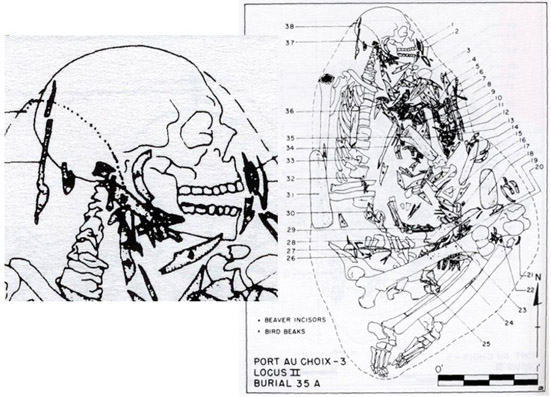
12.
The "shaman" unearthed at Port au Choix in Newfoundland with the beaks
of 200 great auks around his body (pic credit, Tuck, 1976).
What this reveals is that the great auk - whose black feathers, oil and skin were highly sought after by hunters right through to the time of its extinction - was anciently seen as a bird of great supernatural power. It was for this reason perhaps that the Solutreans of Grotte Cosquer in southern France had felt it necessary to depict the seabird's mating ritual.
Where exactly the Göbekli builders might have encountered the greak auk remains unclear, although it is perhaps pertinent to point out that the Swiderian stone tool industry is directly compared with that of the Solutrean peoples of Western Europe. Even V. Gordon Childe (1892-1957), arguably the most famous prehistorian of the twentieth century, wrote that both the Swiderians and Solutreans derived their advanced tool making techniques from the much earlier Eastern Gravettian population (Childe, 1962, 21-2).
If this is the case, then Göbekli Tepe's great auk carving lends weight to the theory that the power elite behind the construction of its earliest enclosures came from or had contact with Swiderian peoples whose original territories stretched as far north as the Baltic coast of Northern Europe. Was this where the ancestors of the Göbekli builders first encountered the great auk?
It remains possible that the Göbekli builders do have more exotic origins, and were indeed the remnants of a lost civilization displaced from the former Sundaland landmass in the wake of the catastrophic events surrounding the Younger Dryas Boundary impact event. It is a matter dealt with thoroughly in Graham Hancock's new book Magicians of the Gods, published in September 2015. Certainly, the sheer diversity of the site's carved art, and its direct comparisons with very similar art in Indonesia, Polynesia, and even Central and South America, is itself persuasive evidence of cross-cultural contact on a global scale, or at least of a cooperation and mutual exchange of ideas between different sea-faring peoples existing at this time. Whatever the answer, at least part of that cross-cultural contact was probably with descendents of the Eastern Gravettian population of Central and Eastern Europe, most obviously the Swiderians, who, like their Solutrean cousins, were master craftsmen when its came to stone tool making techniques.
Not only were the Solutreans perhaps the original sea-kings of the Atlantic Ocean, but they also created the earliest known carved stone panels depicting Ice Age animals in high relief (see, for instance, the carved art of the Roc de Sers grotto in southern France at http://www.donsmaps.com/rocdesers.html). For these reasons alone, the possible role of their extended family in the emergence of Göbekli Tepe should never be overlooked.
Andrew Collins is a historical writer and the author of the book Göbekli Tepe: Genesis of the Gods (2014).
Bibliography
Campmas,
Emilie, Véronique Laroulandie, Patrick Michel, Fethi Amani, "A greak
auk (pinguinus impennis) in North Africa: discovery of a bone remain in a Neolithic
layer El Harhoura 2 Cave (Temara, Morroco)," in Prummel, 233-240.
Childe,
V. Gordon. The Prehistory of European Society. London: Cassell, London,
1958. Revised edition 1962.
Collins, Andrew. Göbekli Tepe: Genesis
of the Gods. Rochester, VM: Bear & Co, 2014.
Hancock, Graham. Magicians
of the Gods. London/New York: Hodder & Stoughton/St Martin's Press, 2015.
Holly
Jr., Donald H. History in the Making: The Archaeology of the Eastern Subarctic.
London: Rowman & Littlefield, 2013.
Little, Greg, with Introduction and
Afterword by Andrew Collins, Path of Souls: The Native American Death Journey.
Memphis, TN: Eagle Wing Books, 2014.
Peters, J., and K. Schmidt. "Animals
in the Symbolic World of Pre-Pottery Neolithic Göbekli Tepe, South-eastern
Turkey: A Preliminary Assessment." Anthropozoologica 39, no. 1 (2004):
179-218.
Prummel, W., J.T. Zeiler, and D.C. Brinkhuizen, Birds in Archaeology.
Eelde, Netherlands: Barkhuis, 2010.
Schmidt, Klaus, "Göbekli Tepe
and the Early Sites of the Urfa Region: A Synopsis of New Results and Current
Views." Neo-Lithics 1, no. 1 (2002): 9-11.
Schmidt, Klaus, Göbekli
Tepe: A Stone Age Sanctuary in South-eastern Anatolia. Berlin, Germany: ex
oriente e.V., 2012.
Speck, Frank G. Bird-lore of the Northern Indians.
Philadelphia, PA: University of Pennsylvania Press, 1921.
Stanford, Dennis
J., and Bruce A. Bradley. Across Atlantic Ice: The Origins of America's Clovis
Culture. Berkeley, CA: University of California Press, 2012.
Tuck, James
A. Ancient People of Port au Choix. Newfoundland Social and Economic Studies
No. 17, Institute of Social and Economic Research, Memorial University of Newfoundland,
St. John's, 1976.